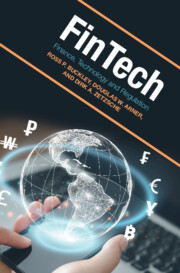Book contents
- FinTech
- FinTech
- Copyright page
- Contents
- Figures
- Acknowledgements
- Abbreviations and Technical Terms
- 1 Introduction
- Part I Digital Transformation of Finance and Regulation
- 2 Evolution of FinTech
- 3 Smart Regulation
- 4 RegTech and the Reconceptualisation of Financial Regulation
- 5 COVID-19, Digital Finance, and Existential Sustainability Crises
- 6 Drivers of Change
- Part II Addressing the Challenges of Innovation in Finance
- Part III Building Better Financial Systems
- Part IV From FinTech to TechFin to BigTech to FinTech 4.0
- Part V Conclusion
- Index
3 - Smart Regulation
from Part I - Digital Transformation of Finance and Regulation
Published online by Cambridge University Press: 09 November 2023
- FinTech
- FinTech
- Copyright page
- Contents
- Figures
- Acknowledgements
- Abbreviations and Technical Terms
- 1 Introduction
- Part I Digital Transformation of Finance and Regulation
- 2 Evolution of FinTech
- 3 Smart Regulation
- 4 RegTech and the Reconceptualisation of Financial Regulation
- 5 COVID-19, Digital Finance, and Existential Sustainability Crises
- 6 Drivers of Change
- Part II Addressing the Challenges of Innovation in Finance
- Part III Building Better Financial Systems
- Part IV From FinTech to TechFin to BigTech to FinTech 4.0
- Part V Conclusion
- Index
Summary
Since the 2008 GFC, financial regulation has increased dramatically in scope and scale. Post-crisis regulation, plus rapid technological change, has spurred the development of FinTech and RegTech firms and data-driven financial service providers. Financial regulators increasingly seek to balance the traditional objectives of financial stability and consumer protection with promoting growth, innovation, and sustainability. This chapter analyses possible new regulatory approaches, ranging from doing nothing (which spans being permissive to highly restrictive, depending on context), cautious permissiveness (on a case-by-case basis, or through special charters), structured experimentalism (e.g., sandboxes or piloting), and development of specific new regulatory frameworks. We argue for a new balanced, risk-based, proportionate approach that incorporates these rebalanced objectives, and which we term ‘smart regulation’.
Keywords
- Type
- Chapter
- Information
- FinTechFinance, Technology and Regulation, pp. 27 - 42Publisher: Cambridge University PressPrint publication year: 2023



